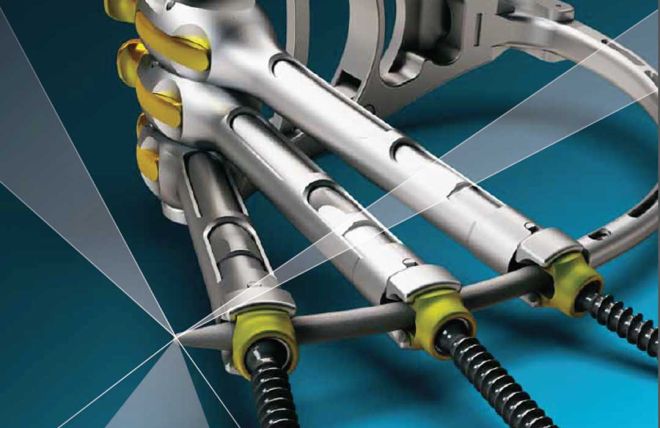Spinal Fusion with Instrumentation
Patients with spinal instability, deformity, or chronic back pain may require spinal fusion surgery. This surgery is done to stabilize and strengthen the spine and to attempt to alleviate severe, chronic back pain. Spinal fusion surgery is a common treatment for such spinal disorders as spondylolisthesis, scoliosis, severe disc degeneration or spinal fractures. Fusion surgery is usually considered only after non-operative therapies have failed.
What is fusion?
Spinal fusion is the joining or fusing of two or more vertebrae. Bone graft is traditionally used to facilitate fusion. This involves small amounts of bone being taken from the patient’s pelvis (autograft), from a donor (allograft), or use of a bone graft sunstitute or BMP, and then packed between the vertebrae in order to "fuse" them together.
Specially designed implants (including cages, rods, hooks and screws) are also often used in a fusion surgery. The implants are used to ensure correct alignment between vertebrae and to help successful fusion to take place. In addition, these implants add strength and stability to the spine while healing progresses.
A fusion is not always achieved after surgery. Fusion rates vary depending on such factors such as whether or not the patient smokes, number of previous procedures, and the underlying pathology. Surgeons are now able to use bone substitutes such as bone morphogenetic proteins (BMPs) during surgery to facilitate fusion. BMP is a "substance" that causes bone growth. The use of BMP in fusion surgery is already improving fusion rates.
TLIF, LLIF, and ALIF
The three most common interbody fusion techniques used to treat chronic low back pain are TLIF, LLIF, and ALIF.
TLIF stands for Transforaminal Lumbar Interbody Fusion. It is a fusion technique done from the back (posterior) of the lumbar spine. The TLIF procedure, or a variation of the procedure, involves three basic steps:
- Pre-operative planning and templating. Before the surgery, the surgeon will use MRI and/or CT scans to determine what size implant(s) the patient will need.
- Preparing the disc space. An incision is made and back muscles are retracted to allow access to the vertebral disc. Minimally or less invasive approaches allow for limited muscle trauma. The surgeon then carefully removes the affected disc and surrounding tissue.
- Implants Inserted. Once the disc space is prepared, bone graft, or BMP with a cage, is inserted to promote fusion between the vertebrae. Additional implants may also be used at this time to further stabilize the spine.
ALIF, which stands for Anterior Lumbar Interbody Fusion, is similar to PLIF. However, it is done from the front (anterior) of the body.
LLIF stands for Lateral Lumbar Interbody Fusion. LLIF is a minimally invasive surgical procedure. Through a small incision at the side of the waist, the damaged disc is removed, and a bone graft is inserted to restore height and alleviate nerve pinching. Over time, the bone graft fuses the vertebrae into a single solid piece, promoting healing and reducing pain.

